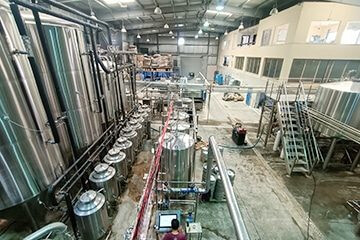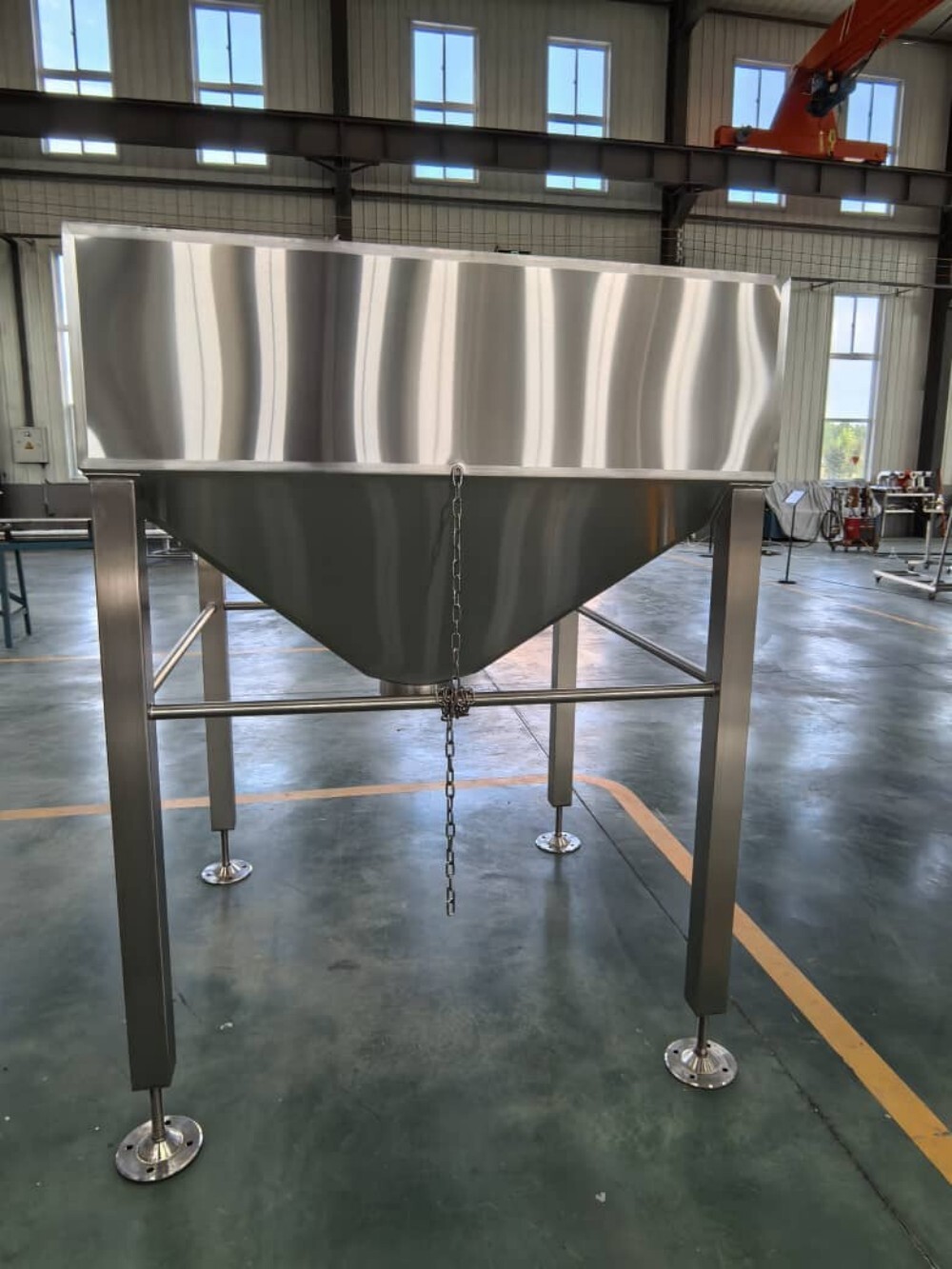
Introduction and scope
Planning floor space for a 1000L Beer fermentation tank requires balancing vessel footprint, service clearances, headroom, and workflow. For information gatherers, business evaluators, and decision-makers, this guide explains how much space a 1000L Beer fermentation tank needs in real brewery layouts, offers calculation methods, references industry standards and provides procurement checklists to support CAPEX and operational decisions. The term "Beer fermentation tank" is used throughout to denote cylindrical, stainless-steel, pressure-capable fermenters commonly used in craft breweries and beverage processing.
Definition and primary parameters of a Beer fermentation tank
A Beer fermentation tank is typically a vertical cylindrical stainless-steel vessel designed for primary fermentation and conditioning of beer. Key parameters that determine required space include: nominal volume (1000L), diameter, height, insulation/jacket thickness, conical cone height (if present), manway and nozzle layout, and external ancillaries such as racking arms, pumps, platform or jacket piping. For a standard 1000L vessel the internal liquid height, headspace, and cone geometry drive most dimensional decisions; therefore, footprint is primarily a function of tank diameter and required service clearance around it.
Footprint calculation methodology (practical example)
To estimate floor area, start from vessel dimensions. Typical internal geometry for a 1000L Beer fermentation tank may be:
- Internal diameter: approximately 800–900 mm (varies with design)
- Cylindrical body height: ~1.5–1.8 m
- Cone height: 300–600 mm (if conical)
- External jacket/insulation: add 50–100 mm to diameter
Example conservative calculation (metric): assume external diameter 1.0 m after insulation. The bare footprint area for one tank = π × (0.5 m)^2 ≈ 0.785 m2. That is only the vessel base; workable planning must include service clearances, operator access and equipment corridors. Industry practice recommends clearances of 600–1000 mm on at least three sides when tanks are installed against a wall on the fourth side, or 800–1200 mm clearances all around for centerline installations in processing aisles. A conservative planning allowance for one 1000L Beer fermentation tank positioned against a wall would therefore be: 0.785 m2 (vessel) + 0.6 m × perimeter clearance allowance (~π×d) ≈ 3.0–4.0 m2 per tank. If accessible from all sides, budget 4.5–6.5 m2 per tank depending on the clearance selected.
Headroom, platform and vertical clearance considerations
Height is as important as footprint. A standard 1000L Beer fermentation tank can have overall heights from 2.0 m to 2.8 m depending on cone, manway, and fittings. Rule-of-thumb vertical clearances:
- Minimum overhead clearance: 300–600 mm above highest nozzle for ladder or crane access.
- For mobilized ceiling cranes or hoists: ensure beam and hook clearance plus 0.5–1.0 m for safe lifting.
- Platforms and catwalks: if you require manway access at the top, provide platform levels at the defined manway elevation—this adds plan area for stairs and railings.
For retrofit projects in older buildings, check finished floor-to-ceiling heights carefully: a 2.6 m tank in a low-clearance room may force selection of a shallower cone or alternative tank design. If your process requires headspace sampling, dry hopping or kegging operations near the top, guarantee a minimum 2.5–3.0 m ceiling height for comfortable operation with a 1000L Beer fermentation tank.
Layout planning: single tank vs. bank installations
Installing a single 1000L Beer fermentation tank differs from planning a bank of multiple tanks. For banks, use shared service aisles, common CIP routing, and grouped controls to reduce per-tank footprint. Examples:
- Back-to-back banks along a wall: place tanks in two rows sharing a central service aisle of 1.2–1.5 m and allow 0.6–1.0 m clearance on outer sides.
- Parallel banks with central walkway: provide 1.4–1.8 m main aisle for forklift or pallet truck access.
When planning CIP and utility runs, factor space for CIP skids and transfer pumps. A recommended option is to integrate a CIP skid next to the fermentation bank; for automated cleaning consider equipment such as Full Aotu CIP Cleaning System which can be positioned adjacent to or between tanks for optimized piping runs and reduced hose lengths. Placing the CIP skid centrally often reduces plumbing complexity and saves long-term labor time during cleaning cycles.
Standards, materials and regulatory considerations
Materials and fabrication standards affect external dimensions (thicker HVAC jackets, insulation). Common references for stainless-steel vessel fabrication include ASME Section VIII (pressure vessels), EN 13445 (unfired pressure vessels) and 3-A / EHEDG guidance for sanitary design in beverage processing. A 1000L Beer fermentation tank intended for pressurized conditioning may need to be ASME-stamped or built to a compliance standard acceptable in your market. Also account for surface finish (typically 2B or electropolished interior) which impacts CIP efficiency and cleaning frequency—both influence operational spacing and access for maintenance.
Procurement checklist and technical specification template
When buying a 1000L Beer fermentation tank, include the following in specifications to avoid surprises:
- Nominal volume: 1000L
- External diameter and overall height (as-built)
- Cone type and angle, cone volume
- Material and internal finish (e.g., SS304/SS316L, Ra value)
- Pressure rating and relief device requirements
- Nozzle positions and orientations (supply drawing with centerline coordinates)
- Insulation and jacket specifications
- Required certifications (e.g., ASME, PED, CE) and testing (MPI, hydrotest)
Case study: retrofit brewery floor planning
A mid-size craft brewery we consulted needed to add three 1000L Beer fermentation tanks into an existing 100 m2 fermentation room. Baseline measurements showed 2.9 m ceiling height and a single service door 1.2 m wide. By selecting externally insulated tanks with 1.05 m diameter and grouping them along one wall with a 1.4 m service aisle, the brewery achieved efficient workflow while leaving space for a 1.2 m wide mobile CIP skid and pump cart. The project reduced installation time by consolidating pipe runs and using a centralized CIP approach, demonstrating how careful footprint planning lowers installation CAPEX and ongoing OPEX.
Cost, alternatives and space-saving options
If floor space is constrained, consider alternatives: horizontal fermenters, stacked fermenter systems, or selecting tanks with shorter cones and integrated platforms. Horizontal tanks trade vertical footprint for longer floor run; they may be useful in low-ceiling buildings but often require more floor area and complicate CIP. Stacked modular fermenters or smaller distributed tanks (e.g., two 500L tanks instead of one 1000L) can increase operational flexibility and reduce single-point failure risk, but increase the number of fittings and CIP cycles. Evaluate total cost of ownership: vessel cost, installation, utilities, CIP complexity and production scheduling will determine whether space-saving alternatives justify the trade-offs.
Common misconceptions and pitfalls
Misconception: A 1000L Beer fermentation tank only needs the vessel footprint. Reality: access, service piping, CIP, ladders and handling clearances multiply required area. Pitfall: buying tanks without accurate as-built dimensions or nozzle coordinates—this causes rework during installation. Pitfall: underestimating headroom for lifting manways or adding insulation. Address these by requesting detailed fabrication drawings and confirming on-site dimensions before final purchase.
FAQ for decision-makers and procurement teams
- Q: How much floor area should I reserve per 1000L Beer fermentation tank?
A: Reserve 3.0–6.5 m2 depending on clearance strategy and whether tanks share aisles. - Q: What ceiling height is recommended?
A: Aim for 2.5–3.2 m minimum; higher if you need lifting or platform access. - Q: Should I buy ASME-certified vessels?
A: It depends on your market and pressure requirements; check local regulations and long-term resale value. - Q: Can I reduce space using a centralized CIP?
A: Yes—centralized CIP like automated skid systems reduces hose storage and simplifies connections, saving aisle clutter.
Why choose us and next steps
We experienced years of development and made ZYB team with the full ability of design, fabrication and commission on higher quality & standard craft brewery system. Our turnkey project approach covers planning, fabrication, on-site installation and commissioning to ensure your 1000L Beer fermentation tank integrates smoothly into existing workflows. For planning support, CAD layouts, or procurement specifications, contact our team to discuss site surveys and customized floor plans. Choosing a partner with integrated stainless steel vessel expertise reduces installation risk and accelerates time-to-production—contact us for a consultation and to request drawings or quotes.
Contact: sales@example.com | Project enquiries: goods-url-1034768
Appendix: quick reference table
In conclusion, determining how much space a 1000L Beer fermentation tank requires depends on vessel dimensions, clearance strategy, headroom and the chosen workflow. Early coordination between process engineers, fabricators and site teams reduces surprises during installation and helps you optimize CAPEX and OPEX for sustainable brewery operation.
Tell us about your brewery equipment requirements!
At ZYB Craft, we’re dedicated to bringing your brewery vision to life. Our expert team of brewers, engineers, and craftspeople is ready to design and manufacture the perfect equipment for your brewing operation. Whether you’re just starting or expanding, we’re here to help. Please leave your specifications, and our team will get in touch to discuss your project in detail. We’ll work closely with you to create equipment that meets your unique needs and budget.
*Rest assured, your information will be kept confidential and used solely for the purpose of assisting you with your brewery equipment needs. We look forward to brewing success together!


